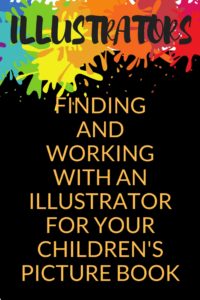Have you sold any writing at all, any place, any time? Yes? That means you need to know about accounting for writers. You know – the tax people want to know how much money you made, and what you spent to make that money, and if you have anything left over as profit at the end of the day. That accounting.
Unfortunately, I’ve never had a course in accounting. When I opened Mims House five years ago, I knew nothing. It’s been a painful five years, partly because I was doing everything on a tight budget which didn’t stretch to hiring an accountant. My husband and I have always done our own taxes, so I thought I could do it. Besides, if I had to spend $500 on something, I wanted to spend it on great art for a picture book, not an accountant to take care of numbers. The choices were always easy to make. To my regret.
Accounting for Writers – Getting Started
I’m still not an expert! You should hire an accountant! Don’t do what I did, but be wiser!
Standard disclaimer: I am not an accountant or a lawyer. You should consult professionals for all your needs.
OK. If you didn’t believe me or if you’re so broke like I was that you really can’t afford an accountant, then I want to tell you my story.
At first, after investigating tons of programs, I went with the standard Quickbooks program. It’s relatively inexpensive, and is widely touted as a good program. It is good–if you know what you’re doing.
I hired an accountant friend to set up the systems for me, and then did my own bookkeeping. I’m using the terms accounting and bookkeeping separately here. Bookkeeping is the practice of recording daily transactions, either purchases or sales. Accounting is slotting all those transactions into categories that make sense and will give you an overview of your business.
Here’s the sad truth: I’d rather write a new chapter than do bookkeeping. Everything was put off and put off and put off. Twice a year, I spent a couple weeks of bookkeeping to catch up, and I moaned during the whole process. I did it twice a year because for a couple projects, I had a partner who needed an accounting twice a year. Until I was required to do that for her, I flat refused to do anything.
Quickbooks worked for a couple years, but it’s been badly broken. I could report my income for taxes, but everything was a mess. I also knew that my accounting wasn’t set up correctly. When you first set up accounting, there’s a chart of accounts that you must create. These are the categories into which transactions are slotted. At first, with only a few books out, I set up an account for each book. Now that I have over 30 books out, that’s cumbersome, redundant and foolish.
A New Accounting Day
This year, I determined that I would sort this out and not let the accounting get so out of hand. For self-published or indie writers it’s all difficult anyway. We want to write, not play with numbers. And it’s complicated. Let’s say that you upload ebooks directly to Apple’s iBookstore. Let’s assume that you sell one ebook to someone in Norway and make a profit of $0.50. You must account for that $0.50, each and every time. Multiply that times 59 countries times the different ebook stores such as Kobo, B&N Press, Publish Drive, Smashwords, StreetLib and so on and so forth. It can be overwhelming.
I wanted something simple that would allow me to keep up on a daily basis. And I wanted to totally redo my chart of accounts to reflect the current status of my business. In other words, I decided on priorities for my accounting, and then went looking. I wanted to remove all the obstacles to doing good accounting, such as manually inputting transactions.
After investigating, I went with Xero.com as the accounting program. It’s an online subscription, so it costs more. However, it has several advantages. First, it pulls in data from my bank daily. In order to make that happen, I changed to an online-only banking account. I still have the local bank account which I have to manually upload once a month. But I’m switching almost all transactions over to the online banking program so that eventually 90% of my transactions will be pulled daily into Xero. To deposit a check, I take a photo of the check to upload. I also chose Xero because I have an eye on selling books online via Shopify, and Xero integrates with that platform. In other words, I was also looking forward and trying to make sure I don’t have switch again anytime soon.
The biggest disadvantage is that Xero is a subscription-based service. I pay monthly. But my business is at a point where I can pay for this convenience, if it makes a difference in my bookkeeping.
And it’s made a huge difference. Instead of manually adding transactions, or manually downloading/uploading from my local bank, the transactions appear like magic in Xero. My new rule is that I must check Xero daily and reconcile all outstanding transactions THAT DAY! So far, it’s working. I am, as of this writing, completely up to date on my bookkeeping and accounting.
While I was at it, I totally redid the chart of accounts. For any given business, the chart needs to be customized. After struggling through a bad chart of accounts for a couple years, I knew the pain points and where I wanted to change it.
Understanding Accounting
It’s not enough, though, to just do bookkeeping and accounting. You need to know what it all means. Are you making a profit? How do you know?
[amazon_link asins=’0814434320′ template=’ProductAd’ store=’patty0d-20′ marketplace=’US’ link_id=’c30748b6-3c1e-11e8-84bf-33479943c7f6′]For me, the answers have been in an amazing book, Accounting for the Numberphobic: A survival guide for small business owners.
Author Dawn Fotopulos says there are three reports that small business owners should understand. And make no mistake: Authors are small business owners!

She says there are three reports you should learn to understand:
- Net Income Statement. Fotopolus says this is comparable to the speedometer of a car, telling you how fast your business is growing.
- Cash Flow Statement. This report is likened to a gas gauge, which tells you how much fuel you have, which in turn tells you how much farther you can go before filling up again.
- Balance Sheet. If you want to know the overall state of your car, though, you should check your oil pressure gauge. Likewise, this report, tells you the overall health of your business.
Fotopolus puts financial terms into simple analogies that make it easy for me to understand. After setting up my new accounting system, I generated these reports and decided that everything is healthy! Fortunately!
Writers don’t talk about accounting much, because we’d rather talk about plotting and characterization. Even subplots and placement of commas is more interesting than accounting. However, if you’re an author, you’re a small business person. That means you should take the time to learn the basic accounting practices. I’m finally on a more solid foundation than before because I took the time to find ways to streamline the process and make it manageable. Probably, your answers won’t be the same as mine, but I urge you to find ways to solve your own accounting problems.



Your advice here is spot on. In my non-writing day job, I am self-employed, teaching financial analysis and related skills to commercial lenders. Financial management is a key answer to the big question: Is this business set up to be successful? Understanding basic financial concepts and accounting, acquiring appropriate tools, such as the program you mentioned, and seeking professional accounting advice when needed–these are investments of time and resources that pay for themselves over the long run. Great, great article!
Thanks for the info, this is something I have struggled with for several years. Very helpful!
Cary